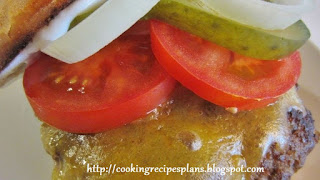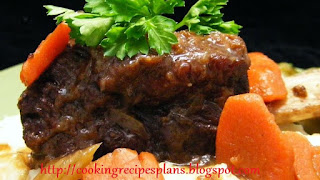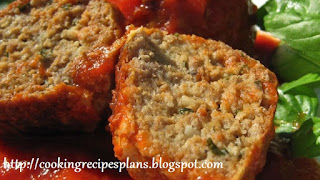 |
| How To Cook The Best Steak In The World |
Every person likes their steak cooked a different way, so throughout this article I will make sure that I cover each possible different way so that you will always get the best result for yourself or whoever you cook for.
There are several different cuts of beef that will make a great steak, and there are also many grades of beef to consider, depending on what the cow was fed on the farm, so your first step is to choose which one you would prefer. The choices include rump, scotch fillet, porterhouse, eye fillet and T-bone as the main premium cuts generally eaten. The beef's grading will come down largely to marbling and maturity of the meat. There is a debate as to which is better out of grain-fed and grass-fed cattle, and really the answer is grass-fed beef is healthier for you as it is the most natural form of the cattle, while grain-fed beef will have a lot more marbling and flavour, so I will leave that choice up to you which way you want to go. As for maturity, I recommend finding a butcher that will hang your meat for quite a long time in their meat locker before carving it, I have found that 27 days is ideal. This will help tenderize the meat by having it stretched out and relaxing the muscles, to give you the best possible final result.
The rump and porterhouse are firmer cuts, and the rump in particular can be a bit tougher and chewier than the rest, and you will find a strip of fat at the top of each of these steaks, which will help flavour and tenderize the steak during the cooking process. Both these cuts I would recommend eating rare to medium-rare (I will discuss steak doneness a little later).
Meanwhile the scotch fillet will come very nicely marbled with fat throughout, and can usually be distinguished by a C-shaped piece of fat close to one side. Due to the marbling it will be very tender and full of flavour (however if you're on a diet it may be one to avoid for now), and I recommend eating it medium-rare to medium.
The eye fillet is the most tender cut of beef, and will normally be free of fat, although this also means you may need to do something extra to add some flavour to it, the most popular way being to wrap bacon around it during cooking, so the fatty flavours of the bacon are absorbed by the steak. This is my personal favourite steak, and is best eaten medium-rare to medium.
Lastly we come to the T-bone, which has both the eye fillet and porterhouse on either side of the bone, and will get its flavour from the strip of fat on the outside of the porterhouse. I recommend eating the T-bone rare to medium-rare, though it can be tricky to cook evenly due to the bone in the middle.
Once you've decided which cut of steak you will be eating, you need to work out how big a piece of meat you want. A normal-sized steak is generally around 300g for a good-sized meal, however it could range anywhere from 150g up to 1kg and even more! The size of your steak will become important later when you want to cook it to a particular doneness. For example, two different rump steaks could quite easily weigh the same amount, yet be completely different shapes, sometimes they can be wide and flat, and sometimes short and thick, depending on what part of the rump the steak was cut from. Choosing the size of your steak and the shape go hand-in-hand, it's best to have a thicker steak for a rare or medium-rare steak, and when you want a medium-well or above thinner is better. This is so it doesn't take a long time for you to cook, and you can still have a juicy steak without burning the outside.
Now let's just get away from the steak for a minute and think about what you're actually going to cook it on. Ideally you should have a chargrill, one that sits on an angle, and has enough space underneath the flame to have a tray that you can put a small piece of wood on. What I personally prefer is mesquite wood, which comes from the USA, and the best thing to do is to soak it in water for a couple of hours before cooking. This will help the wood give off its smoky flavour rather than just burn away, and it will also last longer, usually for at least a couple of hours.
I mentioned earlier that if possible your grill should be built on an angle, sloping up towards the back. As you know, heat rises, so naturally you should find the hottest part of your grill at the back, and get slightly cooler closer to the front. Most grills and hotplates in general will have certain "hotspots" that you will need to find for each one to work out the bests places to position your food when cooking. Once you've used a particular grill a couple of times you should find it quite easy to figure out your favourite spots to cook on. The combination of knowing where your "hotspots" are and using an angled grill will make it easier to find the best position to cook your steak. If you don't have a chargrill to use and you have a flatgrill or a hotplate instead, I would recommend not cooking your steak entirely through on the hotplate, particularly for medium or above, seal it on both sides then place your steak on a tray and finish it off in an oven. Otherwise all you will do is burn the outside and lose all the moisture and juiciness from your meat.
The other element to consider is how you would like your steak cooked. In general, a well-done steak should be placed at the back, a medium steak in the middle of the grill, and a rare steak at the front. Obviously, this leaves medium-rare between the front and middle, and the medium-well between the middle and the back. In some situations you will need to adjust this slightly depending on the size and shape of your steak, a big, thick rump may need to be pushed a bit further up the grill to cook properly, while a thin and flat porterhouse might be best kept a little closer to the front to avoid overcooking. Your steak positioning will come down largely to personal preference and a bit of practice and experience with your grill.
Now that you should have worked out where on the grill you will place your steak, you're almost ready to start cooking! What you need to consider now is how you will season your steak. You may not want any seasoning, that's fine, go right ahead and start cooking. If you wish to use salt and pepper, I would suggest waiting until one side of your steak has been sealed before sprinkling any on, as salt has the tendency to leech out some of the moisture from your meat. My preferred method of seasoning is to get a really good steak seasoning spice and generously cover both sides before placing your steak on the grill. When you do place your steak on the grill, if you are going to have a rump or a porterhouse, make sure you place the strip of fat at the top, so as it cooks the fat will melt and drip through the steak, adding extra flavour to your meat.
The process of actually cooking your steak is quite simple, but there are a few key things you need to know to get the best result. Firstly, the advantage of using the chargrill means you can have nice cross-markings on your steak when it's finished, which looks fantastic for presentation. To achieve this, your steak will need to be turned three times, the first time straight over itself, then on the second turn spin it around 90 degrees so the lines from the grill will cross over each other and make little brown squares all over the steak, and then the third and final turn will be straight over itself again. When you're finished the steak should have cross-markings on both sides, and you can choose whichever side looks best to serve facing up.
What you should find if you have got the grill positioning right for your preferred doneness, 3-4 minutes in between each turn should have your steak turn out just the way you like it! (If you are cooking your steak bleu, you only need to cook it for 3 minutes on each side in total, just enough to seal each side basically).
This is just a guide to work by only, as each grill will produce slightly different results, but definitely the most important stage of cooking your steak is knowing when it is at the exact doneness you would like. This can sometimes be a little tricky, but there are a couple of methods for testing your steak without needing to cut into it. The best method to use when you're just starting to learn would be what I call the "thumb test". Hold your left hand out open and relaxed, and press the flesh of your left thumb with your right index finger. It should feel quite soft, and this is how a rare steak should feel when you press it with your finger.
Now lightly touch your left thumb to your left index finger, and press the flesh of your thumb with your right index finger. This is how a medium-rare steak should feel when it's ready. Next, lightly touch your left thumb to your left middle finger, and pressing the flesh of your left thumb will feel like a medium steak when it's ready.
Touching your left thumb to your left ring finger will make the flesh of your left thumb feel like a medium-well steak, and touching the left thumb to your left little finger will make the flesh of your thumb feel like a well-done steak. Try this out as a guide to get you started, and as with all things, practice and experience will help you hone your ability and instincts to know just when your steak is cooked to perfection! And just as importantly, make sure you get feedback from every person that you cook a steak for, this will make your progress go much faster. As they say, "feedback is the breakfast of champions!"
Another method to use, which can be a little bit sneaky, is if you can see into the middle of the steak at the edges to see what colour the middle looks like. This works really well for a scotch fillet, as you can gently pull away part of the meat right where the C-shaped piece of fat is without damaging your steak, and see if the inside is red, pink or grey.
Now I will explain to you each doneness, so you can work out how you would like to cook it and so you know what to look for when it is finished.
I will start with bleu, which is basically just sealed, is still very red in the middle, quite mushy to the touch, and will feel a little cool inside, only slightly warmed.
Rare is red in the middle from edge to edge, a little mushy, and will just feel warm inside. Medium-rare is red in the middle and pink at the edges, and will feel warm inside. Medium is pink in the middle from edge to edge, feels tender to the touch, and will be warm to hot inside. Medium-well still has a quarter in the middle that is pink, and will be grey at the edges, feels quite firm and is hot inside. If you plan to cook your steak medium-well or above, I would suggest you could speed up the cooking time by using a steak weight to place on top of your steak. It should be shiny silver and kept clean, and what will happen is the heat coming up from the flames below will be reflected down on to the top of the steak so it cooks on both sides. Make sure if you use a steak weight that you only place it on your steak after sealing one side so there is no chance of cross-contamination.
Well-done steaks are grey throughout, no pink at all, quite firm, although can still be juicy, and is very hot inside. Very well-done steaks are grey throughout with no pink at all, very firm, very hot, and no juices whatsoever. You can also get your steak cooked Pittsburgh, which basically means charring the outside so it is burnt while the inside doesn't need to be completely cooked. For example, if you want to have your steak Pittsburgh-Rare, you could char the outside, and the inside would be red in the middle from edge to edge. To do this you will need some oil or butter, I personally use lemon butter just for the flavouring, and drizzle some over the steak until it drips onto the flames underneath. Your goal here is to build the flames up so they are licking at the steak and will cook the outside much faster than the inside.
CAUTION! Be very mindful of how much butter you use, make sure you have fire safety equipment, and if necessary that you have adult supervision. Do not do this if you do not feel comfortable working with large flames, it can be very dangerous if something nearby catches fire, so please be very careful if this is how you would like to have your steak cooked.
Everybody has different preferences when it comes to their beef, but I would urge you to try each different way so you can work out for yourself what's best for you. Many people fear the sight of blood coming out of their steak, if you can work up the courage to try something new for yourself, who know, you might find you really like it! I personally eat my steaks medium-rare, and would like to take this opportunity to mention that once your steak starts getting to medium-well and above, you really lose a lot of the nutritional benefits of eating beef, so I would recommend not cooking your steak any more than medium, but obviously that is a choice that is entirely up to you.
Now all that's left to do is to serve up your perfectly cooked steak, there are many choices of sides and sauces, far too many to list here. I always love it with a creamy mashed potato and seasonal steamed vegetables, and my favourite sauce is mushroom sauce. If you have the time the best sauce is made using beef bones, cooked off with a little tomato paste, then make a stock by boiling the bones in water with some celery, carrots, onion, leeks, bay leaves and peppercorns. Simmer it for a couple of hours until it reduces about three-quarters, and then remove the bones and vegetables. Add some red wine and port, and reduce it down to about half of where it is now, until it starts to thicken with a nice consistency. From here you can add some sliced mushrooms, or peppercorns if you prefer, and even add a little cream if you like as well. This is very time consuming to make the jus (rich beef gravy), but if you can do it you will find it well worthwhile. One other little tip I have for you is to brush a small amount of lemon butter over your steak before saucing it, this will keep your steak very juicy and tender.
I hope you enjoy cooking and eating many steaks in the future, and make sure you go out and impress your friends with your newfound cooking skills!
Source















